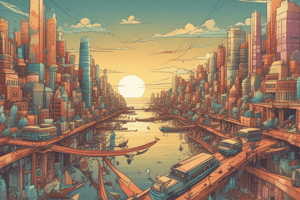Podcast
Questions and Answers
What is the primary characteristic of a trough in a business cycle?
What is the primary characteristic of a trough in a business cycle?
- Low output and employment (correct)
- Low employment rate
- High inflation rate
- High economic growth
What is typically associated with the peak of a business cycle?
What is typically associated with the peak of a business cycle?
- Minimum inflation rate
- Maximum employment rate
- Minimum economic growth
- Maximum output and employment (correct)
What is the significance of the natural rate of unemployment in a business cycle?
What is the significance of the natural rate of unemployment in a business cycle?
- It is the average rate of unemployment during a business cycle
- It is the minimum rate of unemployment that can be achieved (correct)
- It is the lowest point of unemployment during a recession
- It is the highest point of unemployment during a boom
What is the definition of a recession in terms of duration?
What is the definition of a recession in terms of duration?
What is the duration range of U.S. recessions between 1950 and 2009?
What is the duration range of U.S. recessions between 1950 and 2009?
What occurs during a peak in a business cycle?
What occurs during a peak in a business cycle?
What is the primary indicator of a recession?
What is the primary indicator of a recession?
What is the typical pattern of economic activity during a business cycle?
What is the typical pattern of economic activity during a business cycle?
What is the primary cause of cyclical changes in the level of real output according to most economists?
What is the primary cause of cyclical changes in the level of real output according to most economists?
How is the unemployment rate calculated?
How is the unemployment rate calculated?
What happens to discouraged workers in the calculation of the unemployment rate?
What happens to discouraged workers in the calculation of the unemployment rate?
What type of unemployment occurs when a worker loses their job due to a company moving operations to another country?
What type of unemployment occurs when a worker loses their job due to a company moving operations to another country?
What is the term for the unemployment rate that exists when there are no job vacancies?
What is the term for the unemployment rate that exists when there are no job vacancies?
What is the GDP gap?
What is the GDP gap?
If the natural rate of unemployment is 5% and the actual unemployment rate is 7%, what is the GDP gap?
If the natural rate of unemployment is 5% and the actual unemployment rate is 7%, what is the GDP gap?
If the CPI increases from 180 to 190, what is the rate of inflation?
If the CPI increases from 180 to 190, what is the rate of inflation?
What is the inflation rate measuring?
What is the inflation rate measuring?
What is deflation?
What is deflation?
If the price level doubles in 20 years, how long will it take for the price level to quadruple?
If the price level doubles in 20 years, how long will it take for the price level to quadruple?
What is the term for inflation that occurs when the economy's ability to produce output is exceeded by total spending?
What is the term for inflation that occurs when the economy's ability to produce output is exceeded by total spending?
What is the primary purpose of measuring core inflation?
What is the primary purpose of measuring core inflation?
If nominal income rises by 10% and the price level rises by 5%, what happens to real income?
If nominal income rises by 10% and the price level rises by 5%, what happens to real income?
What is the minimum rate of nominal income growth required to maintain a constant real income level if the inflation rate is 8%?
What is the minimum rate of nominal income growth required to maintain a constant real income level if the inflation rate is 8%?
If the CPI is 120 in year 1 and 132 in year 2, what is the rate of inflation?
If the CPI is 120 in year 1 and 132 in year 2, what is the rate of inflation?
What is the definition of a recession in terms of the average price level in the economy?
What is the definition of a recession in terms of the average price level in the economy?
Who is classified as unemployed according to the Bureau of Labor Statistics data on the labor force?
Who is classified as unemployed according to the Bureau of Labor Statistics data on the labor force?
Flashcards are hidden until you start studying
Study Notes
Business Cycles
- A peak in the business cycle is a temporary maximum point, while a trough is a temporary minimum point
- A recession is a decline in real GDP that lasts six months or longer
- The range for the duration of U.S. recessions between 1950 and 2009 was 6 months to 18 months
Unemployment
- The unemployment rate is calculated as (unemployed/labor force) × 100
- Discouraged workers who are not actively seeking employment are excluded from the labor force
- Frictional unemployment refers to search and wait unemployment
- Structural unemployment is when a worker loses a job due to a change in the economy, such as a company moving operations to another country
- Cyclical unemployment is when a worker loses a job due to a downturn in the business cycle
- Full employment refers to the situation when there is no cyclical unemployment
- The full-employment unemployment rate for the United States economy is generally considered to be around 5-6%
GDP and Potential GDP
- Potential GDP is the output that would be produced if the economy was experiencing full employment
- If the GDP gap is positive, it means that actual GDP is greater than potential GDP
- If the GDP gap is negative, it means that actual GDP is less than potential GDP
- The higher the rate of unemployment, the larger is the GDP gap
Inflation
- The inflation rate measures the percentage growth rate of the Consumer Price Index (CPI) from one year to the next
- Deflation is when the CPI declines from one year to the next
- Demand-pull inflation occurs when total spending is greater than the economy's ability to produce output at the existing price level
- Core inflation refers to the inflation picture after stripping away food and energy prices
- If the CPI rises from 125 to 140 from one year to the next, the rate of inflation is approximately 12%
Studying That Suits You
Use AI to generate personalized quizzes and flashcards to suit your learning preferences.




